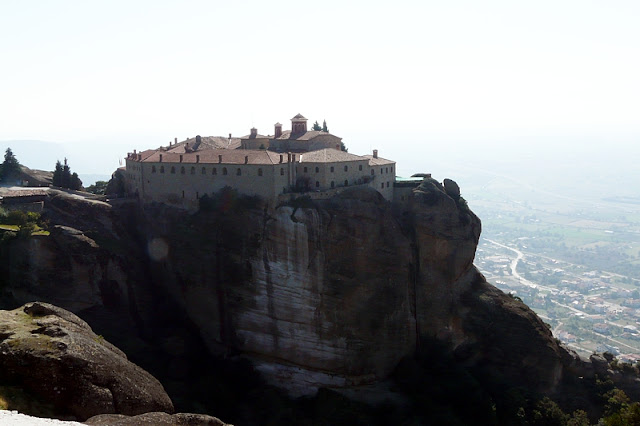Monastyr Świętego Stefana jest jednym z sześciu monastyrów należących do kompleksu Meteory w Grecji. Skała, na której stoi klasztor, oddzielona jest od masywu głęboką przepaścią, nad którą znajduje się stały most. Jest to jedyny klasztor widoczny od strony miasta Kalambaka.
The St. Stephen's Monastery is one of the six monasteries of the Meteora in Greece. Rock on which stands the monastery, is separated from the massive by the deep precipice, over which there is a bridge. It is the only monastery seen from the Kalambaka.
Monastyr Świętego Stefana, The Monastery of St. Stephen
Pierwszy klasztor założono prawdopodobnie w 1192. Obecne zabudowania zostały wybudowane w I połowie XV wieku przez św. Antoniego, syna władcy serbskiego i księżniczki bizantyjskiej. W 1545 roku św. Filoteusz rozbudował stary katolikon pod wezwaniem św. Stefana i dodał wiele budynków mieszkalnych i gospodarczych. W 1798 wzniesiono katolikon pod wezwaniem męczeństwa św. Charalambosa, którego głowa znajduje się w klasztorze. W czasie II wojny światowej klasztor został zbombardowany przez hitlerowców. Od 1961 roku klasztor św. Stefana jest zamieszkiwany przez siostry zakonne.
The first monastery was founded probably in 1192. The current buildings were built in the first half of the fifteenth century by Saint Anthony, the son of the Serbian ruler and the Byzantine princess. In 1545 St. Philotheus expanded the old katholikon of St. Stephen and added a residential buildings. In 1798 was erected new katholikon dedicated to the martyred St. Charalambos, whose head it contains. During World War II, the monastery was bombed by the Nazis. Since 1961, the Monastery of St. Stephen is inhabited by nuns.
Monastyr Świętego Stefana, The Monastery of St. Stephen
Najstarszym budynkiem zespołu klasztornego jest główna świątynia klasztoru (katolikon) pod wezwaniem św. Stefana. Jest ona jednonawową bazyliką z narteksem, a jej wnętrze zdobią malowidła z początku XVI wieku, przedstawiające sceny z życia Chrystusa, Bogurodzicy i wizerunki licznych świętych. Okazały nowy katkolikon pod wezwaniem św. Charalambosa jest świątynią posiadającą absydę, dwa aneksy, przedsionek, nawę główną, obejście i kopułę główną podpartą na czterech filarach. Charakterystyczną cechą są wysokie, wysmukłe kopuły: główna nad nawą i dwie boczne ponad aneksami absydy. Podczas II wojny światowej budowla została zniszczona, a w 1972 odbudowana. Najcenniejszym elementem wystroju kościoła jest bogato rzeźbiony drewniany ikonostas z 1814, zaliczany do najpiękniejszych w Grecji. Znajduje się tu również czaszka św. Charalambosa.
The oldest building of the monastery is the main temple of the monastery (katholikon) dedicated to the St. Stephen. It is a one-nave basilica with narthex, and its interior is decorated with paintings from the early sixteenth century, depicting scenes from the life of Christ, the Virgin Mary and numerous images of saints. The impressive new kathkolikon of St. Charalambos is a temple having the apse, two annexes, vestibule, nave, bypass and the main dome propped up on four pillars. A characteristic feature is high, slender dome: above the nave and two annexes. During World War II the building was destroyed and rebuilt in 1972. The most valuable element of the interior of the church is richly carved wooden iconostasis from 1814, belonging to the most beautiful in Greece. There is also a skull of St. Charalambos.

